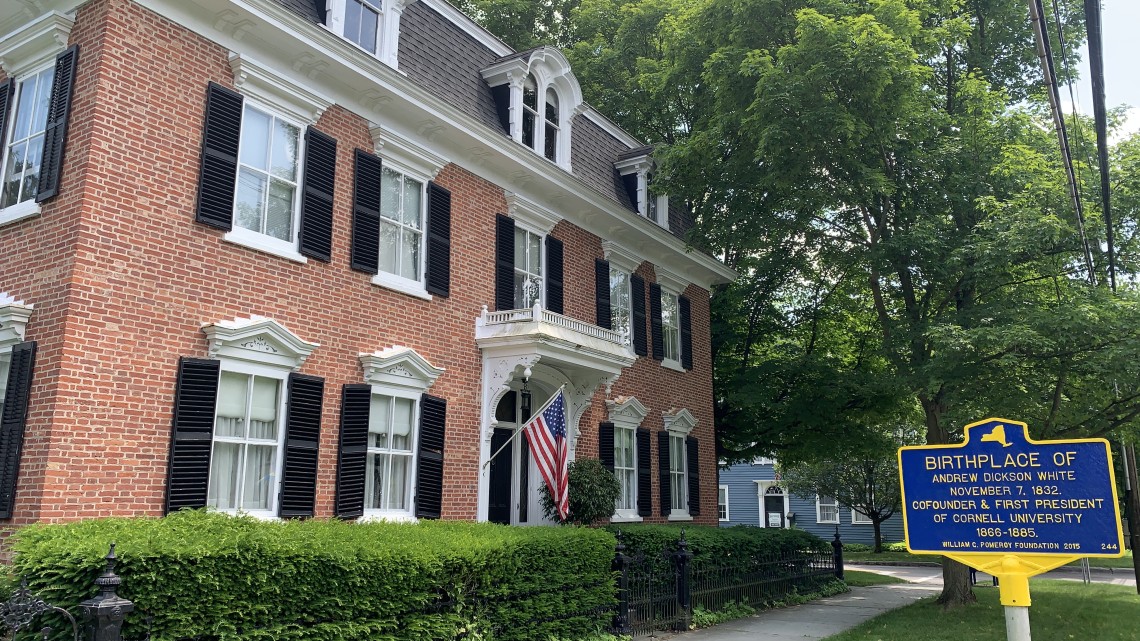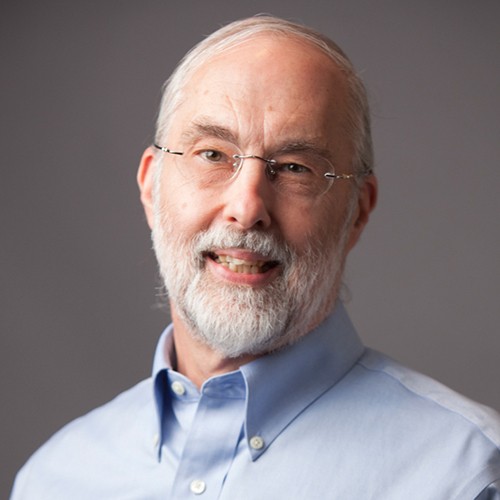
SCE's Dean Charles W. Jermy, Jr. secured landmark status for Andrew Dickson White's birth home in Homer, NY. Photo: Shelley Preston
News directly from Cornell's colleges and centers
SCE's Dean Charles Jermy, Jr., honors July 4th and Cornell history in Homer, NY
By Shelley Preston
As a loyal student of history, Charles W. Jermy, Jr., interim dean of Cornell’s School of Continuing Education (SCE), stops shy of calling himself a native of Homer, New York, the small village where he’s lived since he was 6 years old.
But it’s probably safe to say that the rest of his community would consider him to be one of its most cherished sons: A champion of its rich history and a man dedicated to sharing the village’s place in the founding of the United States and of Cornell.
Among Jermy’s many acts of community service in and around Homer is a public reading of the Declaration of Independence on the village green on the Fourth of July, an event he’s organized for nearly three decades, and securing a landmark for Andrew Dickson White’s birth home on Main Street.
Historian Corey Ryan Earle ’07, who specializes in Cornell’s history, said of the landmark designation, “It's wonderful to have this piece of local history celebrated and preserved to recognize White's legacy. Andrew Dickson White is sometimes overlooked as the co-founder of Cornell University since the institution's name honors Ezra Cornell. White had an enormous impact on the university and globally as a scholar, diplomat and leader in higher education.”
SCE asked Dean Jermy about his interest in preserving Cornell history in Homer and his tradition of reading the Declaration of Independence there every Independence Day.
SCE: Thank you, Dean Jermy, for sharing your historical endeavors with us. Homer is about 20 miles northeast of Ithaca, New York, so it’s interesting to hear about its connection to Cornell history. But before we talk about A.D. White’s birth house—he’s of course one of the co-founders of Cornell University—let’s talk about your upcoming public reading of the Declaration of Independence this July 4 at 10 a.m. How long have you done this for your community?
Jermy: This will be the 27th year. We first did it in 1995.
SCE: Can you tell us how you started the tradition and your interest in reading it in its entirety for the public?
Jermy: One year, the pastor of our church, who had been a naval officer, recommended to the congregation that we read the Declaration of Independence on the Fourth of July. Coincidentally, I had read in The New York Times about this village that had been doing a reading of the Declaration for many years. I don't remember exactly how many but, it was quite a few. I became interested in doing a reading of it in Homer.
My son, Charles (Chip) W. Jermy III ’03, has been involved with it from the beginning, too. We were Village of Homer co-historians. Chip was 18 years old when he was officially appointed as a municipal historian. We believe he's the youngest in New York State to be appointed.
Our family read the Declaration together that first year. Afterwards, we thought, why don’t we do this as a public reading next year at the bandstand on Homer’s village green? We did that for years. We now hold it in the Center for the Arts of Homer.
SCE: How was the first reading received?
Jermy: That first year, only three people attended besides our family, but now in its 27th year, we have a couple of hundred people who come to the reading, and they are from all over. Some have been coming for years, others are new to the experience. We’ve had people from the local area, politicians running for office, history buffs, at least one Cornell dean and readers of all ages from 6 to some in their 90s.
SCE: Can you tell us a bit about how the reading is staged and what the audience can expect? We spoke to Andrew Karolyi, the Charles Field Knight Dean at the Cornell SC Johnson College of Business, and he said this of the experience: “My wife, Anne, and I read about an event in the Old Homer Historical District in which the community gathers to read together the Declaration of Independence. We were delighted to learn that Bud [Jermy’s nickname] and his family lead this event,” he said.
“We also learned stories about the important people and circumstances that led to its adoption in 1776. It was beautifully told, with respect and pride. It was truly emotional to participate together in its shared reading. We are thankful to Bud and the Jermy family for contributing in this meaningful way to our community.”
Jermy: Andrew and Anne greeted me after one of the readings, and they were extremely kind in their review of Chip’s and my introductory remarks. I was pleased to have a professional colleague join us.
And so, yes, we start with some interesting history about Independence Day. For example, did you know that only two people signed the document on July 4? The official separation was on July 2 when the Declaration of Independence from Britain was voted on. July 4 was when the whole document was presented to the Continental Congress. We describe the fates of some of the signers. After we finish the history, we invite people to come up to read. We parse out sections of the Declaration of Independence into little segments and anyone can read and be a part of it.
SCE: What have been some memorable moments from the readings over the years?
Jermy: I remember one year a family on vacation from New York City drove several hours out of their way to come so that their children could have an experience of hearing the Declaration of Independence read, so that was quite extraordinary. We've fired cannons on the green—also memorable. We’ve been able to toll the bells of the nearby churches and the school 50 times after we finished the reading and it’s become a kind of grand Homer tradition.
SCE: Let’s talk about Andrew Dickson White’s birth house in Homer. We understand you led the way for it to become landmarked by the William G. Pomeroy Foundation, which funds New York State historic markers.
Jermy: Yes. Andrew Dickson White was born in his grandparents’ house on the corner of Main Street and Albany Street in Homer. It's a beautiful, old brick house. I thought there ought to be a marker there. We went to the William G. Pomeroy Foundation and we received funding for the monument. We dedicated it a few days after A.D. White’s 186th birthday, which was on November 7, 2015.
SCE: Tell us more about the process of researching the home and getting the landmark designation.
Jermy: New York State used to provide historic markers and then, perhaps 50 years ago, they stopped. William G. Pomeroy, a businessman from Syracuse, decided that it was a worthwhile thing to fund and he established a foundation to do so after he sold his company.
To get a place to qualify for a sign, you must find primary documents that prove that the event to be commemorated occurred at that spot. In the case of Andrew Dickson White’s birth house, I used several different documents. For example, I used White's passport and the entry in his autobiography where he talks about his childhood in Homer. I also found a letter in which he described visiting the house in which he was born, and he identified it as his grandfather’s home.
SCE: Where did you find these documents?
Jermy: The Cornell University archives was helpful and I have copies of Andrew Dickson White’s autobiography, so I knew where that was.
SCE: You seem to have a special connection to Homer. Where does that come from?
Jermy: I’m a true Central New Yorker. I was born in Rochester, but have always lived in Homer, apart from going away to college. I've been a resident of Homer since I was 6 years of age, so this will be my 70th year. It’s a special place: Our village green is still there with the churches and elementary school. Across from them is the fire station and a home for older residents, the library, and so you know, it feels like one of the New England towns from which its early settlers came.
SCE: You are the president of the Board of Trustees of the Cortland County Historical Society and your family played a role in the creation of the Central New York Living History Center. Can you tell us what visitors can find at the center?
Jermy: This is a large complex that includes three museums that focus on local, train and military history; Brockway Trucks (that were manufactured in Cortland) and the region’s agricultural heritage.
SCE: Your dedication to local and national history is inspirational.
Jermy: History provides important lessons about human nature and its fallibility. I’ve found that, by studying history, I and others can frequently identify false assumptions and better correct our understanding of the past and present. Having such knowledge can be invaluable as we contemplate and plan for our future.
--------
Dean Jermy invites the public to the annual reading of the Declaration of Independence on July 4 at 10 a.m. at the Center for the Arts of Homer, 72 S. Main St., Homer, NY. The event is free and open to all.
The Andrew Dickson White birth home is located at 81 S. Main St., Homer, NY.
Read the full version of this story in SCE news.
Shelley Preston is the School of Continuing Education and Summer Sessions’ communications and marketing specialist.
Media Contact
Get Cornell news delivered right to your inbox.
Subscribe


